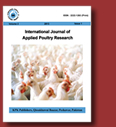|
|
|
|
|
|
|
|
Serotypes and antimicrobial resistance patterns of
avian Escherichia coli isolates from healthy and diseased
chickens in Arusha city, Tanzania
|
|
Sanka, P.N1.,
Karimuribo, E.D.2 and Muhairwa, A.P.2 |
|
1Tanzania Veterinary Laboratory Agency, Zonal Office
P. O. Box 1068, Arusha, Tanzania;
2Department
of Veterinary Medicine & Public Health,
Sokoine University of
Agriculture,
P.O. Box 3000 Chuo Kikuu, Morogoro,
Tanzania
|
|
| Abstract |
|
Investigation on avian pathogenic Escherichia coli (APEC) in clinically healthy and diseased commercial chickens
was conducted between December 2012 and February 2013 in Arusha City, Tanzania. One-hundred
seventy six (75.9%) E. coli
isolates were obtained from 168 cloacal swabs from healthy chickens and
64 visceral organs of sick chickens were subjected to bacteriological
culture, biochemical tests, antimicrobial susceptibility test and
serotyping using O1, O26 and O78
E. coli antisera. The results showed that 81.0%; (n= 136) of cloacal
swabs and 62.5% (n= 40) of visceral organs carried
E. coli. Findings of
serotyping showed that 65 (36.9%) were identified as pathogenic strains
belonging to serotype O1 (30), O26 (6) and 078 (29)
E. coli isolates. Whereas (63.1%, n=111) of the isolates were
untypable with the panel of antisera used. Serotype O1 was significantly
more prevalent in visceral organs than in the cloacal swabs (P<0.05).
Antimicrobial susceptibility studies showed high resistance to
Sulphamethoxazole (98.3%), Cotrimoxazole (97.7%) and Ampicillin (42.6%).
Multiple resistance to two and more antimicrobials were observed and
ranged between 0.6 and 43.2%.
High proportions of isolates were found to be susceptible to Gentamycin
(97.2%), Streptomycin (85.9%) and Kanamycin (83.6%). The findings
of APEC strains in the diseased chickens as compared to healthy flock
suggest the involvement of these strains in the pathological process as
a primary or secondary invader. However, further investigations are
required to understand the link of pathogenic strains to other chicken
diseases.
A high proportion of
E. coli isolates was
resistant, including multiple resistance to
commonly used antimicrobial.
Further investigations on E. coli by serotyping, molecular typing
and antimicrobials susceptibility studies are recommended.
|
|
Keywords:
Antimicrobial; commercial chickens;
E. coli; prevalence; Tanzania
|
| |
| To cite this article:
Sanka
PN, Karimuribo ED and Muhairwa AP, 2016.
Serotypes and antimicrobial resistance patterns of
avian Escherichia coli isolates from healthy and diseased
chickens in Arusha City, Tanzania.
Res.
Opin.
Anim. Vet. Sci., 6(6): 185-193. |
|
|

